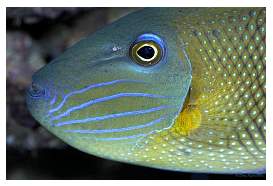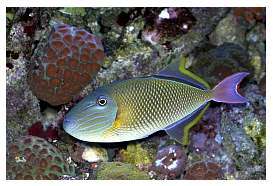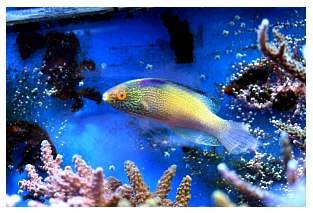|
Hugo Zuniga's (snipersps) Reef
Aquarium
Introduction & Background:
My name is Hugo
Zuniga and I am originally from Mexico City. I now live in
Westminster, CA. My screen name on Reef Central is snipersps,
but in reality my son, Bryan (right), is the real snipersps,
since he is the one who does most of the hard work, including
answering all my private messages and e-mails, and helping
me post pictures, because I have very little knowledge of
computers.
I started in the aquarium hobby about five years ago. Our
first tank was a 5-gallon that my son purchased at a swap
meet one day. We started with goldfish that, for some unknown
reason, always died the day after we got them. Because we
knew very little about keeping fish, we always changed the
entire tank's water and even washed it with soap! But as time
went by we started to read and learn how to keep fish. From
there, our next tank was a 40-gallon long tank which contained
cichlids. As the fish started to grow, our next upgrade was
to a 60-gallon, and then on to a 100-gallon tank. After that
I purchased a used 135-gallon tank, which is when I first
started a reef tank. It was at this point that my addiction
began.
My Addiction:
My addiction started with the 135-gallon
tank housing only soft corals. That lasted only about four
months as I began to introduce small-polyped stony corals.
At first I was not so thrilled with these types of corals
since I told myself that they were not as interesting as soft
corals moving with the current. Two-and-a-half years passed
and I soon upgraded to my current 300-gallon system.
|
System Profile:
|
|
300-gallon Lee Mar euro-braced,
96"L x 30"W x 24"H |
|
|
200-gallon
sump w/40-gallon in-sump refugium |
|
|
100-gallon
fragment tank |
|
|
Custom-built
stand and canopy |
|
|
|
Joining Reef Central only made my addiction worse. As I met
more and more people online, I started to buy and trade with
them - from San Francisco to New York, from one coast to the
other. One of the most influential people who really helped
with my small-polyped stony coral addiction was Carlos (pucci).
Every weekend I went to his house and admired his tank, wishing
that mine looked only half as good as his, and every week
he sent me home with my hands full of coral fragments. All
of my small-polyped stony coral colonies started as 1-1.5"
fragments. I also went through some rough times when I introduced
a Montipora that had pest nudibranchs. At first, I
thought they where some kind of fish food, but as time went
on I noticed that a lot of my corals were dying. Then one
day someone told me that the nudibranchs were the cause of
all of my headaches. I was able to save some corals, but lost
most of them. Then, a few months later I noticed that my corals
were losing their colors and some were even dying. It was
then that I realized that I had RED BUGS! After four treatments
I was finally rid of them, but I did lose all of my shrimp,
copepods and hermit crabs. Now my system is the way you see
it here.
The Tank:
The tank is a 300-gallon (96"
x 30"x 24") reef-ready manufactured by Lee Mar with
a custom-built stand and canopy of cherry-stained solid oak
and oak plywood. It has been up and running for two-and-a-half
years. There is also a 100-gallon fragment tank connected
to the main display that's used for growing and propagating
Acanthastrea and Micromussa as well as various
other stony corals.
Filtration:
Filtration is provided by a My Reef
Creations MRC-4 dual Beckett injector skimmer powered by an
Iwaki 70 pump. Biofiltration is accomplished with about 500
lbs. of live rock and a 3" sand bed. A 200-gallon sump
is also used for filtration with about 100 lbs. of live rock,
and also contains mixed macroalgae ranging from Caulerpa
to Chaetomorpha, which help with nutrient export.
Water
Parameters:
|
|
Calcium:
~400 ppm |
|
|
Alkalinity:
9-10 dKH |
|
|
pH
8.0 - 8.2 |
|
|
Nitrate:
0 |
|
|
Phosphate:
0 |
|
|
Temperature:
76 - 77.5° F |
|
|
|
Circulation:
Water is returned to the display tank
by a Sweetwater external pump pushing 3500gph to the fragment
tank and three returns to the main display that exit through
1" Sea Swirls. For additional flow I use a Tunze 6080
and a Seio 820.
|
Photos courtesy of Mario Chavarria.
|
|
Photos courtesy of Mario Chavarria.
|
Lighting:
|
Main
Tank Photoperiod:
|
|
9:00
am - actinics on
|
|
|
10:30
am - halides on
|
|
|
9:30
pm - halides off
|
|
|
10:00
pm - actinics off
|
|
|
|
The system is lit by four 400-watt
20K metal halides under Luminarc III reflectors and one 250-watt
double-ended 14K metal halide. The two end bulbs are 20K XM
and the others are 20K Radium. The XM bulbs are driven by
a Bluewave 7 dual ballast; the Radiums are powered by a dual
PFO HQI ballast. The 250-watt is a 14K Phoenix bulb on a Bluewave
HQI ballast. I also use four T5 HO Superblue+ for supplemental
lighting.
Other Equipment:
In order to maintain a stable temperature
I use a ½ hp Aqualogic chiller plumbed to a Little
Giant pump. The chiller is plumbed to the main display tank
and is controlled by an Aqualogic temperature controller.
Heat is provided by two 300-watt heaters. Calcium levels are
maintained by using a My Reef Creations CR-6 dual-chamber
calcium reactor connected to a Pinpoint pH controller. Alkalinity
is maintained by a My Reef Creations Neilson reactor connected
to a Reef Sentry dosing pump used for freshwater top-off.
A 40-watt UV sterilizer is also connected to the system.
|
Photos courtesy of Mario Chavarria.
|
|
Photos courtesy of Mario Chavarria.
|
|
Photos courtesy of Mario Chavarria.
|
|
Photos courtesy of Mario Chavarria.
|
|
Photos courtesy of Mario Chavarria.
|
Maintenance:
A 50-gallon weekly water change is
used to keep the nutrients down. The RO/DI water is mixed
with Tropic Marine salt. The skimmer's neck is cleaned weekly
so that it performs at its best, and its Beckett injectors
are cleaned every other week.
Feeding:
The tank is fed daily with a variety
of foods including frozen brine shrimp, Mysis and Cyclops-Eeze.
Every third day I also mix in some Liquid Life BioPlankton®
with the Cyclops-Eeze to feed the clams. I typically feed
only once a day in the late afternoon prior to the lights
tuning off.
|
Photos courtesy of Mario Chavarria.
|
Inhabitants:
The display tank has a variety of
corals and fishes. Small-polyped stony corals dominate the
tank, but there are still a few soft corals such as Ricordea,
leather corals and various mushrooms. It also houses quite
a few large-polyped stony corals, e.g., Blastomussa
spp., chalice, Echinophyllia, Cyphastrea and
Acanthastrea.
|
Fish:
|
|
2
Cirrhilabrus rhomboidalis - Golden Rainbow wrasses
|
|
1
Cirrhilabrus lineatus wrasse
|
|
2
Wetmprella sp. - Possum wrasses
|
|
1
Cirrhilabrus jordani - Flame wrasse
|
|
1
Pseudocheilinus ocellatus- Mystery wrasse
|
|
1
Centropyge aurantia - Golden angel
|
|
1
Genicanthus melanospilos - Japanese Swallowtail
angel
|
|
1
Zebrasoma flavescens - Yellow tang
|
|
1
Zebrasoma xanthurus - Purple tang
|
|
10
Apogon compressus - Blue eyed cardinals
|
|
4
Dunckerocampus pessuliferus pipefish
|
|
1
Corythoichthys sp. - Dragon pipefish
|
 |
 |
 |
|
Corals:
|
|
Acropora
sp. - Red staghorn
|
Acropora
sp. - Green w/pink tips
|
|
Acropora
tenuis
|
Acropora
yongei w/blue tips
|
|
Acropora
navini
|
Acropora
sp. - Purple, unknown
|
|
Acropora
valida
|
Acropora
sp. - Tri-color staghorn
|
|
Acropora
sp. - Loisatae staghorn
|
Acropora
sp. - Blue staghorn
|
|
Acropora
sp. - California tort
|
Acropora
sp. - Oregon deep blue tort
|
|
Acropora
sp. - Yellow tort
|
Acropora
sp. - Miyagi tort
|
|
Acropora
yongei - blue
|
Acropora
sp. - O.R.A. blue stag
|
|
Acropora
solitaryensis
|
Acropora
efflorescens
|
|
Acropora
millepora - pink
|
Acropora
millepora - red
|
|
Acropora
millepora - blue
|
Acropora
millepora - lime green
|
|
Acropora
sp. - O.R.A. chips (blue-tipped)
|
Acropora
sp. - rainbow
|
|
Acropora
tricolor - Bali
|
Acropora
sp. - Purple bonsai (GARF)
|
|
Acropora
lokani - blue
|
Acropora
sp. - Purple monster
|
|
Acropora
sp. - Purple staghorn
|
Cyphastrea
sp. - three different varieties
|
|
Montipora
danai
|
Sunset
Montipora sp.
|
|
Rainbow
Montipora sp.
|
Montipora
confusa
|
|
Green
Montipora sp. w/purple rim
|
Green
Montipora sp. w/pink polyps
|
|
Montipora
hispida
|
Ricordea
florida
|
|
Trachyphyllia
sp. - Red green brain coral
|
Goniopora
sp.
|
|
Various
Acanthastrea spp.
|
Various
Micromussa spp.
|
|
Blastomussa
spp.
|
Favites
pentagona - War coral
|
|
Echinophyllia
sp. - watermelon
|
Red
Echinophyllia sp.
|
|
Blue
Echinophyllia sp.
|
Pink
blue Echinophyllia sp.
|
|
Pink
green Echinophyllia sp.
|
Echinophyllia
maliformis
|
|
Note: all corals are believed
to be these species.
|
Acknowledgements:
I would like to thank everyone at
Reef Central for helping to make my dream come true. It's
an honor to have been chosen for Tank of the Month. I would
also like to thank my family for all the support they have
given me, especially my son Bryan. It's because of him that
I started into this hobby. Additionally, I'd like to thank
Greg Rothschild (gregr) and Mario Chavarria (mchava) for their
wonderful photography.
For more information visit Hugo's website:
Unless otherwise noted photos courtesy
of Greg Rothschild.
Feel free to comment
or ask questions about my tank in the Tank of the Month thread
on Reef Central.
|
If you'd like
to nominate a tank for Tank of the Month, click here
or use the button to the right.
|
 |
|

